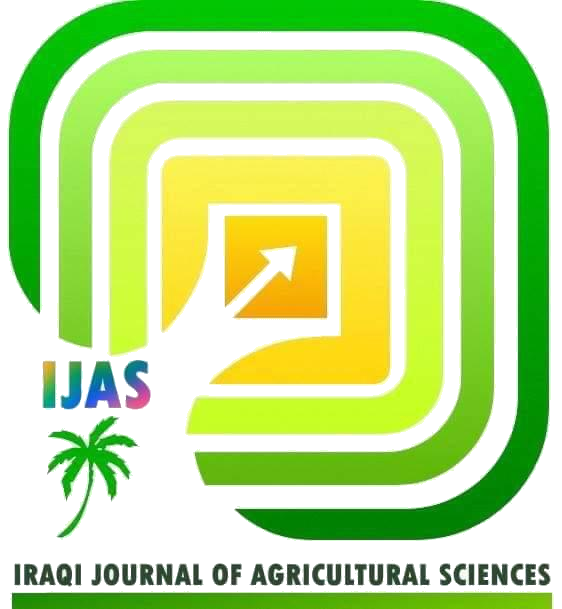MICROMORPHOLOGICAL STUDY FOR POLLENS AND SEEDS FOR FIVE SPECIES BELONG TO BRASSICACEAE FAMILY IN IRAQ
DOI:
https://doi.org/10.36103/5wr54b81Keywords:
pollen grains, SEM, Reticulate , Lepidium., mucous layer.Abstract
This study was aimed to investigate the micro-morphological characteristics of pollens and seeds for five species of the Brassicaceae family in Iraq belonging to the genus Lepidium, and species of Lepidium sativum L., L.ruderale L. , L.perfoliatum L., L.aucheri Boiss, and L.latifolium L. The characteristics of the pollen grains included the shape of the grain, the length of the equatorial and polar axis, the distance between the two grooves and the groove length , as well as the grain surface configuration. The seeds spherical in shape, while the other species were elongated in shape. As for the seeds, they were studied by the Dissect microscope and the scanning electron microscope (SEM), and all their morphological characteristics were studied the shape, dimensions (length and width), colors, as well as the presence of the mucous layer, that all the seeds of the species contained a mucous layer, but they varied in their thickness, and the surface configuration of the seed surface varied between zigzag reticulate, reticulate different shapes, pitted reticulate, and elongated reticulate.
References
1. Ahmed,Z.A. and S. A. Aliwy 2023. Taxonomical study for the species Chenopodium album L. and Chenopodiastrum murale L. belong to Amaranthace (Chenopodiaceae) at Baghdad .Iraqi Journal of Agricultural Sciences :54(1),pp.32-41: https://doi.org/10.36103/ijas.v54i1.1674
2. Ahuja,I.,Roholff,,J. ,and A.M., Bones .2011. Defence mechanism of Brassicaceae: implications for plant-insect interactions and potential for integrated pest management.SustainableAgricultureVolume2, 623-670. DOI: 10.1051/agro/2009025
3. AI-Joboury,k.r. and Zurgany L.M. 2024 .Investigation of wild land plants of the riparian areaof the Dujail river Salahaldin province,north of Baghdad,Iraq.Bulletin of the Iraq Natural History Museum 18(2):315-356. https://doi.org/10.26842/binhm.7.2024.18.2.0315.
4. AI-Sahli, A. A. and M., EL-Zaidy, 2021. Occurrence of calcium oxalate crystals in some wild plant used in traditional medicine in saudi Arabia .Journal of Medicinal Plants Research ,15(2): 96-107 . DOI:10.5897/JMPR2020.7040
5. Al-Dobaissi, I. A. M. 2023. Chemical analysis of new recorded species Acalypha australis L. at Iraq. Iraqi Journal of Agricultural Sciences, 54(3), 674-681. https://doi.org/10.36103/ijas.v54i3.1745 .
6. Al-Eisawi, D. 2016. Taxonomic synopsis of Brassicaceae for the flora of Jordan. Webbia, 71(2): 219-226 https://doi.org/10.1080/00837792.2016.11843
7. AL-Masoudi,R.K.H.,Al-Dobaissi,I.A.R.M. 2022.A taxonomic study of species Peltariaangustifolia DC.from Brassicaceae family in Iraq , Iraqi Journal of Science 63(12),pp.5147-5156 DOI:10.24996/ijs.2022.63.12.6
8. Al-Mayah, A. A. .2013. Medicinal plants and herbal medicine (, Dar and Insights Library for printing, publishing, distribution and media, Beirut.p. 358 . https://doi.org/10.62810/jns.v4i2.215
9. Al-Munqedhi, B. M., M. A. El-Sheikh, A. H. Alfarhan, A. M. Alkahtani, I. A. Arif, R. Rajagopal and S. T. Alharthi. 2022. Climate change and hydrological regime in arid lands, impacts of dams on the plant diversity, vegetation structure and soil in Saudi Arabia. Saudi Journal of Biological Sciences, 1(29):3194-3206 https://doi.org/10.1016/j.sjbs.2022.01.04
10. Al-Shehbaz, I. A., Beilstein, M. A., & Kellogg, E. A. (2006). Systematicsand phylogeny of the Brassicaceae (Cruciferae): an overview. Plant Systematics and Evolution, 259(2), 89-120
DOI:10.1007/s00606-006-0415-z.
11. Bona, M. 2013. Seed- coat microsculpturing of Turkish Lepidium (Brassicaceae) and systematic application.Turk.J.Bot 37:662-668. DOI:10.3906/bot-1207-2
12. Çıtak, B. Y. and H. Dural, 2020. The anatomical structures of the Genus Iberis L. (Brassicaceae) In Turkey”, Bangladesh Journal of Plant Taxonomy, 27(2), 213-224. DOI:10.3329/bjpt.v27i2.50662
13. Dewa ker, B. T., P. K. Dutta, B. R. Lokesh, and K. A. Naidu, 2010. Physico-Chemical properties of garden cress (Lepidium sativum) seed oil, AOCs 87,539-548. DOI:10.1007/s11746-009-1523-z.
DOI:10.46309/biodicon.2021.773419
14. Erden, A., and Y. Menemen. 2021. Comparative pollen Morphology studies on some species of Brassicaceae in Turkey. Biyolojik Çeşitlilik ve Koruma, 14(1), 105-118. 12
15. Gabr, D. G. 2018. Significance of fruit and seed coat morphology in taxonomy and identification for some species of Brassicaceae. American Journal of Plant Sciences, 9(03), 380. DOI:10.4236/ajps.2018.93030
16. Gökbayrak, Z. and H., Engin, 2016. MicroMorphology of Pollen Grains of some Grape Cultivars. In VII International Scientific Agriculture Symposium, "Agrosym2016," pp: 176-180 DOI:10.31015/jaefs.2021.3.4
17. Hani, M.; R. Lebazda, and M. Fenni1, 2017. Studies of morphological characteristics and production of seeds weeds of species of family Brassicaceae (Cruciferous) in Setifian High Plateau, Algeria. Annual Research & Review in Biology, 12, 1-9. https://doi.org/10.9734/ARRB/2017/33473
18. Khan, K. A., and H. A. Ghramh. 2021. Pollen source preferences and pollination efficacy of honey bee, Apis mellifera (Apidae: Hymenoptera) on Brassica napus crop. Journal of King Saud University-Science, 33(6), 101487. https://doi.org/10.1016/j.jksus.2021.101487
19. Kaya, A., Ünal, M., Sefali, A., & Martin, E. 2019. Fruit and seed macro-and micromorphologies of the genus Matthiola (Brassicaceae) in Turkey and their taxonomic value. Turkish Journal of Botany, 43(4), 516–528
DOI:10.3906/bot-1812-10.
20. Othman, O. M. and R. M Hamad. 2022. Pollen Micromorphological Study of Ten Genera of Brassicaceae in West Iraq Desert. In IOP Conference Series: Earth and Environmental Science (Vol. 1060, No. 1, p. 012103). IOP Publishing https://doi.org/10.1088/1755-1315/1060/1/012103
21. Othman,O.M. and R.M. Hamad.2024. New record for Iraqi flora of the genus and species Morettia philaeana (Cruciferae) in Iraq. Iraqi Journal of Agricultural Sciences :55(4):1434-1442 DOI: https://doi.org/10.36103/z55y5p05
22. Pakravan, M., Nazem Bokaee Z. Bolourian, S. 2011. A biosystematic study on the four varieties of Alyssum minus (Brassicaceae) in Iran. – Iran. J. Bot., 17(1): 55-62 10.22092/IJB.2011.10155 doi:
23. Qasim,S.A., and A. S. Ali .2020.Effect of Pomegranate Juice and fresh leaves of Eruca vesicaria on Testosterone hormone level in blood serum of male rabbits .Systematic Reviews in Pharmacy,11(10):1211-1214 DOI:10.31838/srp.2020.10.172 .
24. Satil, F., A. Kaya and M. Ünal (2018). Fruit, seed and pollen morphology of Chorispora DC species (Brassicaceae) of Turkey. Bangladesh Journal of Botany, 47(3), 459-466 DOI:10.3329/bjb.v47i3.38712
25. Sirin, E., B.Y. Citak, and K. Ertugrul 2022. Morphological, Anatomical and Palynological features of Alyssum strigosum Banks and Sol. (Brassicaceae). Erzincan University Journal of Science and Technology , 15(1): 80 – 92. DOI:10.18185/erzifbed.9779
26. Sukeyna, A. A.; G. A. Lobab and Al- H. R. H. Newani, 2023. Comparative taxonomical study for preproductive part of eight species belong to Brassicaceae family in Iraq. Iraqi Journal of Agricultural Sciences:54(1):25-31 https://doi.org/10.36103/ijas.v54i1.1673
27. Tantawy, M. E., M. I. Husein, M. M. Mourad and U. K. Abdel- Hameed. 2021. Comparative Floral Anatomy of Some Species of Brassicaceae and its Taxonomic Significance. Adansonia, 43(20): 223-234 https://doi.org/10.5252/adansonia2021v43a20 .
28. Umber, F., M. Zafar, R. Ullah, A. Bari, M. Y. Khan, M. Ahmad and S. Suktana .2021. Imolicatiin of light and scanning electron microscopy for pollen morphology of selected taxa of family asteraceae and brassicaceae. Microscopy Research and Technique, 85(1): 373-384.
DOI:10.1002/jemt.23912
29. Vedi, F. S. 2025. An Overview of New Methods in Plant Taxonomy. Journal of Natural Sciences – Kabul University, 4(2), 109–117. https://doi.org/10.62810/jns.v4i2.215
30. Yildirim, B., H. Dural and B. Y. Citak 2021 . Morphological study on Diplotaxis tenuifolia (Brassicaceae). Biyolojik ve Koruma, 14(3), 365-371. DOI:10.46309/biodicon.2021.897954
31. Yousefi, A. and Ako, K. 2020. Controlling the rheological properties of wheat starch gels using Lepidium perfoliatum seed gum in steady and dynamic shear.Int J.Biol Macromol,143:928- DOI:10.1016/j.ijbiomac.2019.09.153 .
Downloads
Published
Issue
Section
License
Copyright (c) 2025 IRAQI JOURNAL OF AGRICULTURAL SCIENCES

This work is licensed under a Creative Commons Attribution-NonCommercial 4.0 International License.

2.jpg)


